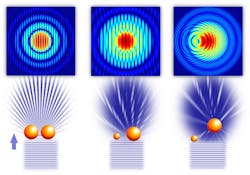Laser Captures Hologram of a Virus
X-ray holography of nano-sized objects has so far been limited to those that form crystals, or else involved careful positioning of samples on a surface. However, many nano-sized particles are non-crystalline, short-lived, and fragile. They may also change or be damaged when being positioned on a surface. Aerosols, exotic states of matter, and the smallest forms of life often fall into these categories, and therefore are difficult to study with conventional imaging methods.
But now, engineers at the DoE’s SLLAC National Accelerator laboratory have invented a new holographic method called in-flight holography. They’ve used it to take the first X-ray holograms of nano-sized viruses that were not attached to any surface.
Scattered X-ray light from a minivirus is superimposed with scattered X-ray light from a reference sphere (main image). The curvature in superimposed images from both objects provided depth information and details about the shape of the virus. The image in the lower right corner is a holographic reconstruction of the virus based on X-ray diffraction patterns collected during the experiment. (Courtesy: Anatoli Ulmer and Tais Gorkhover/The Technical University of Berlin and SLAC National Accelerator Laboratory)
Patterns needed to create the images were taken at the Linac Coherent Light Source (LCLS), the X-ray free-electron laser at SLAC. Nanoviruses have been studied at LCLS without a holographic reference, but the interpretation of the X-ray images required many steps, relied on human input, and was a computationally challenging task.
In the new method, the researchers superimposed scattered X-ray light from the virus with scattered X-ray light from a reference nano-sized sphere. The curvature in the superimposed images from the two objects provided depth information and details about the shape of the 450-nanometer-wide virus, the minivirus. This technique greatly simplified the interpretation of the data.
“Instead of thousands of steps and algorithms that potentially don’t match up, you have a two-step procedure where you clearly get the structure out of your image,” says lead researcher Tais Gorkhover, a Panofsky Fellow at SLAC. Now, scientists can reconstruct a sample in fractions of a second.
These Illustration show the principle of in-flight holography. (Left) X-rays scatter off two spheres and form a characteristic diffraction pattern. The patterns are recorded using SLAC’s X-ray laser, the Linac Coherent Light Source. (Center) Changes in the spheres’ size and distance are reflected in the patterns which can be directly translated from the diffraction alone. The smaller sphere can act as a holographic reference. (Right) If the spheres are shifted out of plane, the fine lines of the diffraction pattern become curved. The signatures of the position and size of the reference let researchers reconstruct 3D distances between the small (reference) and large spheres. (Courtesy: Anatoli Ulmer and Tais Gorkhover/The Technical University of Berlin and SLAC National Accelerator Laboratory)
“Before our new method, interpreting the X-ray images was complicated, and the structure of nanosamples was reconstructed long after the actual experiment using non-trivial algorithms,” says Christoph Bostedt, a scientist at the DOE’s Argonne National Laboratory. “With ‘in-flight’ holography, the procedure is simple and in principle can be performed while taking data. This is a real breakthrough.”
“Another advantage of the in-flight holography method is that it is less prone to noise and to the artifacts that can appear in the detector compared to non-holographic X-ray imaging,” adds Anatoli Ulmer, a Ph.D. student from the Technical University of Berlin in Germany.
In the long run, the researchers predict that in-flight holography will offer new ways to study air pollution, combustion, and catalytic processes, all of which involve nanoparticles.



